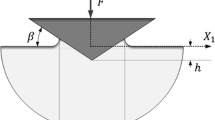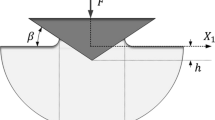Abstract
Finite element simulations are performed to analyze the contact deformation regimes induced by a sharp indenter in elastic – power-law plastic solids. As the yield strength (σys) and strain hardening coefficient (n) decrease or, alternatively, as Young’s modulus (E) increases, the contact regime evolves from (i) an elastic–plastic transition, to (ii) a fully plastic contact response, and to (iii) a fully plastic regime where piling-up of material at the contact area prevails. In accordance with preliminary analyses by Johnson, it is found that Tabor’s equation, where hardness (H) = 2.7σr, applies within the fully plastic regime of elastic – power-law plastic materials. The results confirm the concept of the uniqueness of the characteristic strain, ∈r = 0.1, that is associated with the uniaxial stress, σr. A contact deformation map is constructed to provide bounds for the elastic–plastic transition and the fully plastic contact regimes for a wide range of values of σ ys, n, and E. Finally, the development of piling-up and sinking-in at the contact area is correlated with uniaxial mechanical properties. The present correlation holds exclusively within the fully plastic contact regime and provides a tool to estimate σ ys and n from indentation experiments.
Similar content being viewed by others
References
D. Tabor, Hardness of Metals, (Clarendon Press, Oxford, United Kingdom, 1951).
R. Hill, E.H. Lee, and S.J. Tupper, Proc. R. Soc. A 188, 273 (1947).
F.J. Lockett, J. Mech. Phys. Solids 11, 345 (1963).
W. Yu and J.P. Blanchard, J. Mater. Res. 11, 2358 (1996).
R.F. Bishop, R. Hill, and N.F. Mott, Proc. Phys. Soc. 57, 147 (1945).
D.M. Marsh, Proc. R. Soc. A 279, 420 (1964).
R. Hill, The Mathematical Theory of Plasticity (Clarendon Press, Oxford, United Kingdom, 1950).
W. Hirst and M.G.J.W. Howse, Proc. R. Soc. A 311, 429 (1969).
K.L. Johnson, J. Mech. Phys. Solids 18, 115 (1970).
Y.A. Laursen and J.C. Simo, J. Mater. Res. 7, 618 (1992).
A.E. Giannakopoulos, P-L. Larsson, and R. Vestergaard, Int. J. Solids Struct. 31, 2679 (1994).
P-L. Larsson, A.E. Giannakopoulos, E. Söderlund, D.J. Rowcliffe, and R. Vestergaard, Int. J. Solids Struct. 33, 221 (1996).
V. Marx and H. Balke, Acta Mater. 45, 3791 (1997).
A. Bolshakov and G.M. Pharr, J. Mater Res. 13, 1049 (1998).
M.M. Chaudhri, Acta Mater. 46, 3047 (1998).
Y-T. Cheng and Z. Li, J. Mater. Res. 45, 2830 (2000).
S. Biwa and B. Storåkers, J. Mech. Phys. Solids 43, 1303 (1995).
A.F. Bower, N.A. Fleck, A. Needleman, and N. Ogbonna, Proc. R. Soc. A 441, 97 (1993).
K. Komvopoulos, J. Tribol. 110, 477 (1988).
S.D. Mesarovic and N.A. Fleck, Proc. R. Soc. A 455, 2707 (1999).
ABAQUS User’s Manual V5.8 (Hibbitt, Karlsson & Sorensen Inc., 1999).
I.N. Sneddon, Int. J. Eng. Sci. 3, 47 (1965).
J. Alcalá, A.C. Barone, and M. Anglada, Acta Mater. 48, 3451 (2000).
G. Eason and R.T. Shield, ZAMP 11, 33 (1960).
J. Alcala, J. Am. Ceram. Soc. 83, 1977 (2000).
R. Hill, B. Storåkers, and A.B. Zdunek, Proc. R. Soc. A 423, 301 (1989).
A.L. Norbury and T. Samuel, J. Iron Steel Inst. 17, 673 (1928).
K.L. Johnson, Contact Mechanics (Cambridge University Press, Cambridge, United Kingdom, 1985).
M. Mata, M. Anglada, and J. Alcala, Philos. Mag. A (in press).
P-L. Larsson, Int. J. Mech. Sci. 43, 895 (2001).
Author information
Authors and Affiliations
Corresponding author
Rights and permissions
About this article
Cite this article
Mata, M., Anglada, M. & Alcalá, J. Contact Deformation Regimes Around Sharp Indentations and the Concept of the Characteristic Strain. Journal of Materials Research 17, 964–976 (2002). https://doi.org/10.1557/JMR.2002.0144
Received:
Accepted:
Published:
Issue Date:
DOI: https://doi.org/10.1557/JMR.2002.0144




